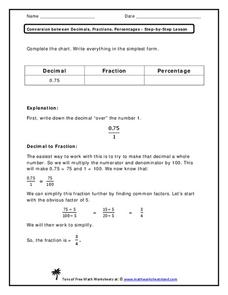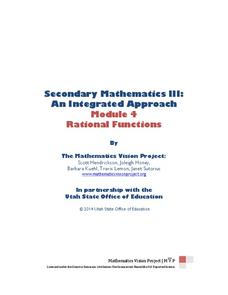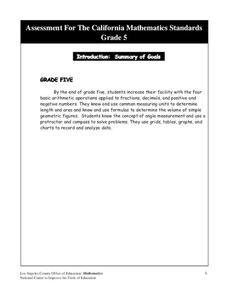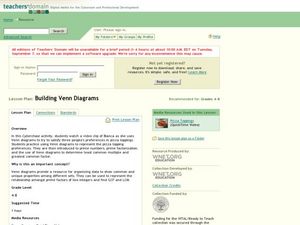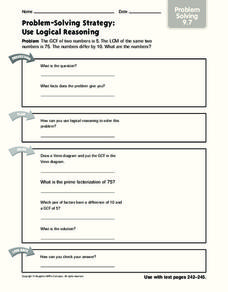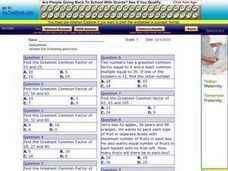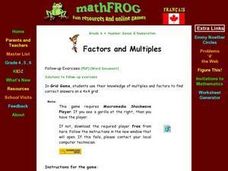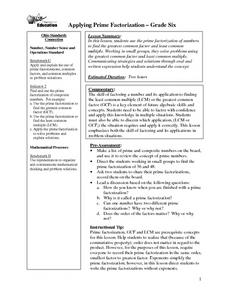Curated OER
Math Review
In this algebra worksheet, students review least common multiples and word problems. There are 10 interactive questions with an answer key.
Curated OER
What Does Greatest Common Factor Mean to Me?
Pupils see a demonstration of the concept of factors through modeling. They do an activity that help them explain further the concept of common factors and greatest common factor.
EngageNY
Polynomial, Rational, and Radical Relationships
This assessment pair goes way beyond simple graphing, factoring and solving polynomial equations, really forcing learners to investigate the math ideas behind the calculations. Short and to-the-point questions build on one another,...
EngageNY
Obstacles Resolved—A Surprising Result
The greater the degree, the more solutions to find! Individuals find the real solutions from a graph and use the Fundamental Theorem of Algebra to find the remaining factors.
EngageNY
Discovering the Geometric Effect of Complex Multiplication
Does complex number multiplication have the class spinning? Here's a resource that helps pupils explore and discover the geometric effect of multiplying complex numbers. In the 14th installment in the 32-part unit groups look at the unit...
EngageNY
The Power of Algebra—Finding Primes
Banks are responsible for keeping our financial information safe. Mathematics is what allows them to do just that! Pupils learn the math behind the cryptography that banks rely on. Using polynomial identities, learners reproduce the...
Curated OER
Twenty Questions: The Hundred Chart
Use the 20 Questions game to practice math vocabulary and number properties! Project a hundreds chart and hand one out to learners. Ideally, give them counters (beans would work well) to mark off the chart so you can play multiple times....
EngageNY
Numbers in Exponential Form Raised to a Power
Develop an understanding of the properties of exponents through this series of activities. This third lesson of 15 explores the patterns associated with the power property. Scholars expand the powers before applying the property.
EngageNY
Matrix Notation Encompasses New Transformations!
Class members make a real connection to matrices in the 25th part of a series of 32 by looking at the identity matrix and making the connection to the multiplicative identity in the real numbers. Pupils explore different matrices and...
Math Worksheets Land
Conversion between Decimals, Fractions, Percentages - Step-By-Step Lesson
A helpful math worksheet, intended as a guided lesson, walks young mathematicians through the process of converting the decimal 0.75 to a fraction and percent.
Mathematics Vision Project
Module 4: Rational Functions
Time to study the most sensible function — rational functions! The seven-lesson unit develops the concept of a rational function through a connection to rational numbers and fractions. Scholars graph functions, solve equations, and...
Los Angeles County Office of Education
Assessment for the California Mathematics Standards Grade 5
Test young mathematicians' knowledge with an assessment aligned to California's fifth grade state standards. The exam covers a multitude of concepts including fractions and decimals, positive and negative numbers, measurement; and how to...
Curated OER
Building Venn Diagrams
Young scholars use Venn diagrams to solve prime number and factorization problems. In this multiplication lesson, students watch a video and use a Venn Diagram to help them solve a pizza math activity that uses prime factorization. Young...
Curated OER
Problem-Solving Strategy: Use Logical Reasoning
In this problem-solving worksheet, students solve 1 mathematical word problem by figuring out the answers to 7 questions. Students record their answers on the lines provided.
Curated OER
Solving Algebra
In this algebra worksheet, students define greatest common factors, least common factors and solve word problems dealing with GCF and LCM. There are 10 questions with an answer key.
Curated OER
Factors and Multiples
Sixth graders need to see the relevance in the mathematics they learn. This lesson builds on the concepts of least common multiple and greatest common factor. The lesson presents real-world problem situations for students to solve.
Curated OER
Applying Prime Factorization
Sixth graders use the prime factorization of numbers to find the greatest common factor and least common multiple. Working in small groups, they solve problems using the greatest common factor and least common multiple.
Curated OER
Least Common Multiple
In this least common multiple worksheet, students review the steps for finding the least common multiple using lists of multiples and prime factorization. Students then list multiples to find the LCM for the given numbers. Students then...
Curated OER
Prime Factorization with Factor Trees (1 of 2)
Six numbers (12, 32, 50,48,36, and 75) are given to learners to craft factor trees with. The first one is completed as an example in this first of two similar online worksheets. Note that where factorization is an foundational step in...
Curated OER
My Test Book: Factors and Prime Numbers
In this online interactive math skills worksheet, students solve 10 multiple choice math problems regarding factors and prime numbers. Students may submit their answers to be scored.
Curated OER
Leveled Problem Solving: Least Common Multiple
In this least common multiple practice learning exercise, students sharpen their problem solving skills as they solve 6 story problems.
EngageNY
Comparing Methods—Long Division, Again?
Remember long division from fifth grade? Use the same algorithm to divide polynomials. Learners develop a strategy for dividing polynomials using what they remember from dividing whole numbers.
West Contra Costa Unified School District
Simplifying Radicals – Day 1
It doesn't get simpler than this. Scholars first learn to simplify radicals by determining the prime factors of the radicand. The instructional activity progresses to simplifying radicals involving algebraic expressions in the radicand.
West Contra Costa Unified School District
Simplifying Fractions
Encourage family participation at home with a reference tool designed to support learners' practice of simplifying fractions. Two pages offer detailed descriptions and labeled examples.











